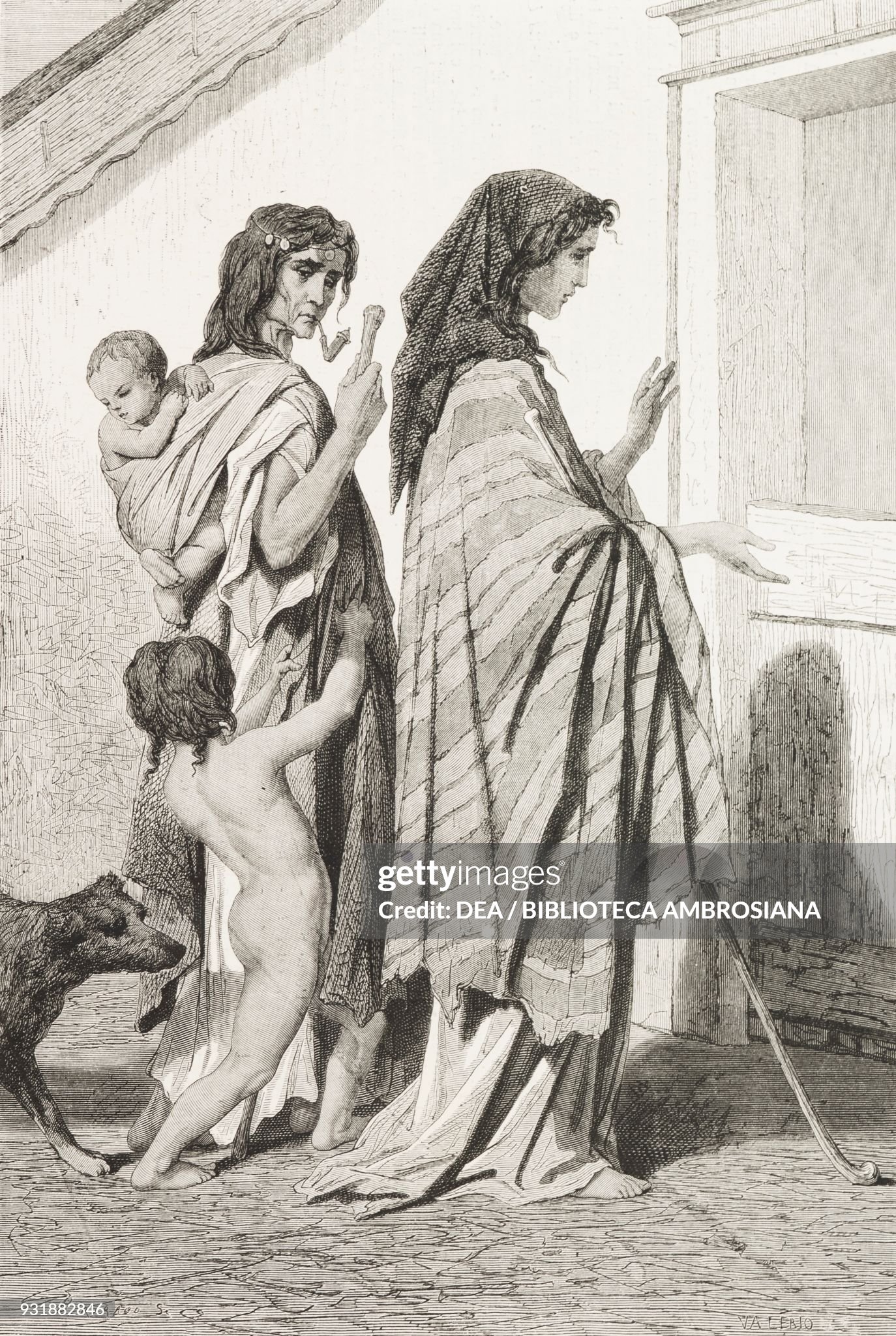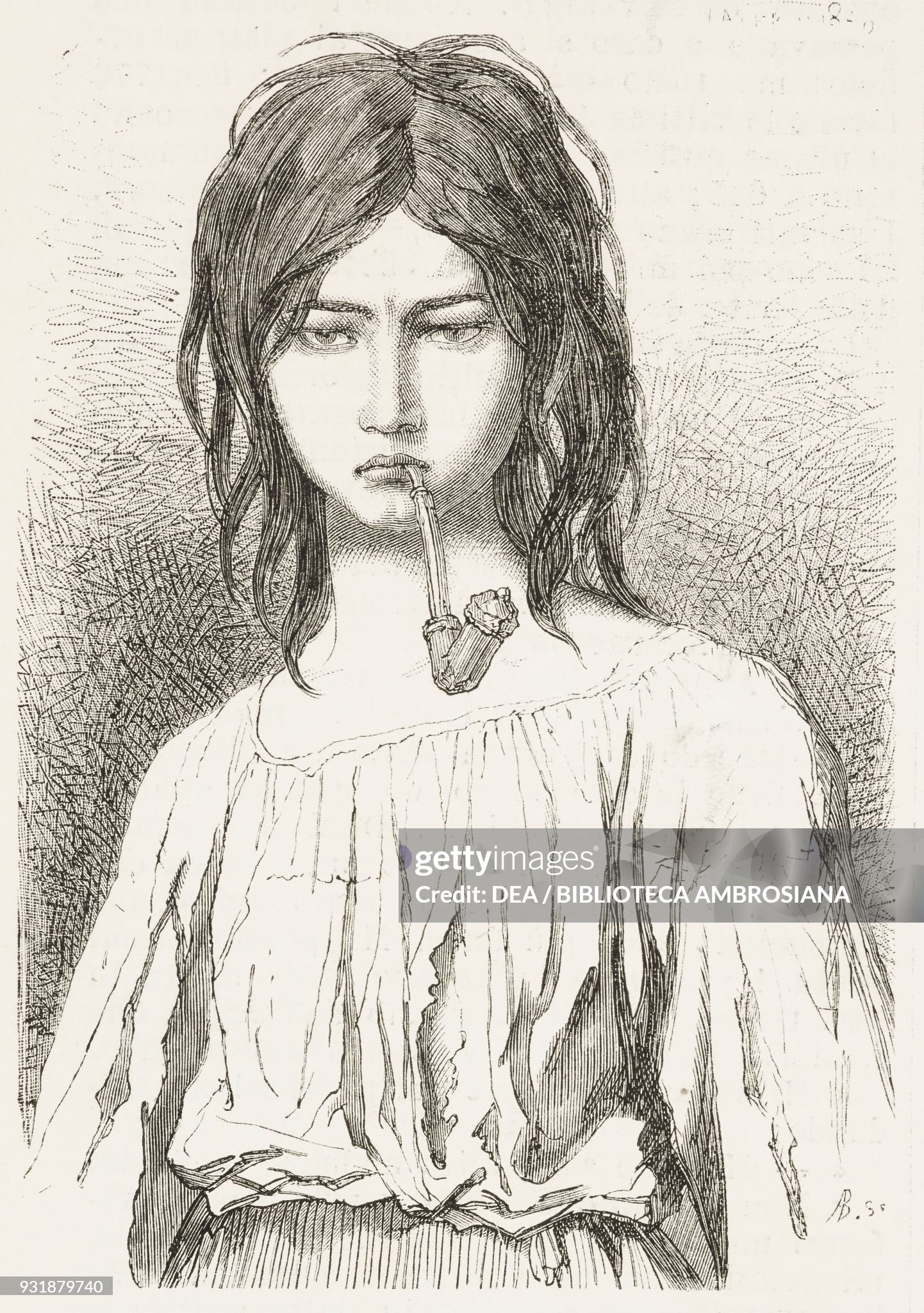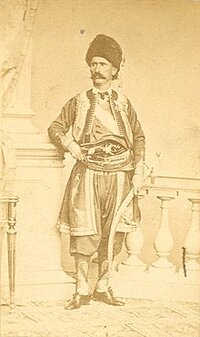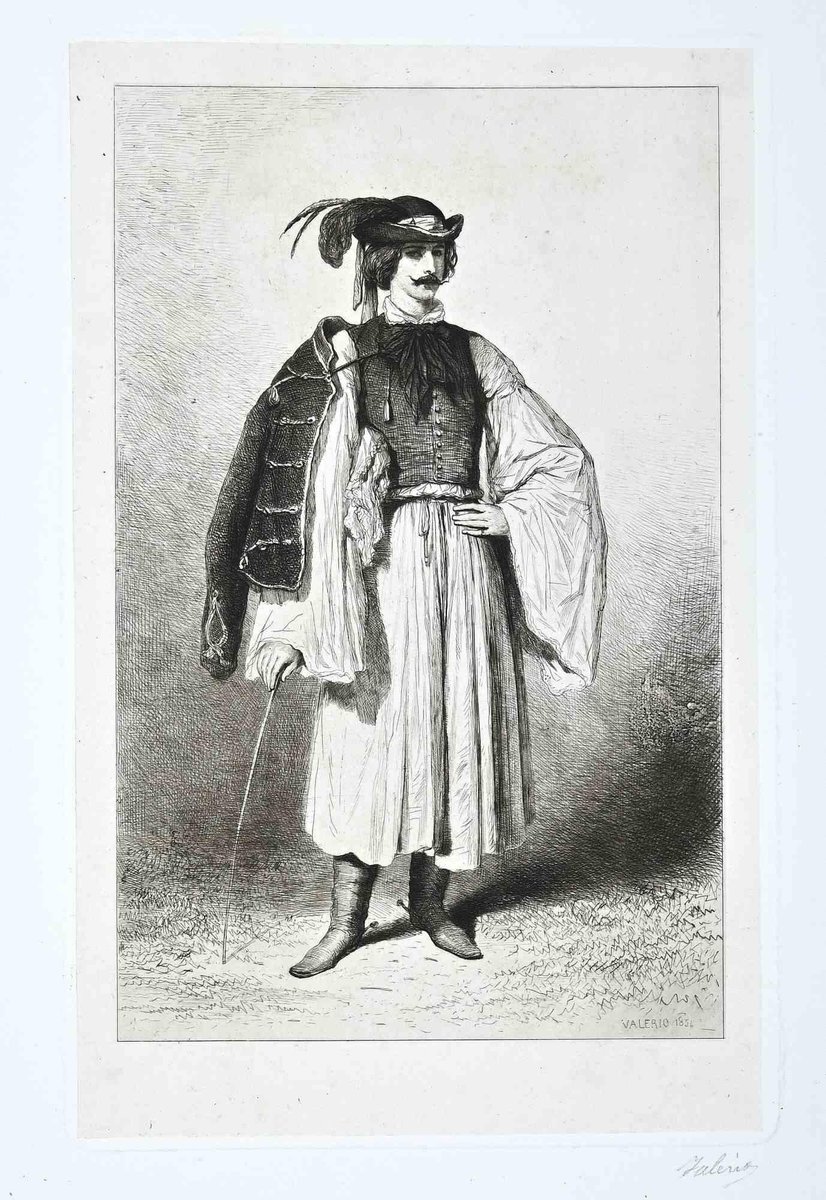théodore valerio
herserange 1819 - vichy 1879

Biography
Of Italian origins, Théodore Valério was born in the Moselle region of eastern France, not far from the border with Luxembourg, and entered the Parisian studio of Nicolas-Toussaint Charlet in 1834. The two artists soon became friends, and in 1836 travelled together on a sketching tour of Germany, Switzerland and Italy. Valério made his public debut in 1838, at the age of nineteen, at the Salon des Artistes Vivants. He continued to exhibit at the Salons until his death, winning a third-class medal in the category of engraving in 1859. A painter, engraver and draughtsman, he produced landscapes, genre scenes and military subjects. He was an inveterate traveller, and in the 1840s and 1850s made extensive tours of Italy, Switzerland, Germany, Austria, Hungary and Romania, as well as the Balkans and Turkey. During the Crimean War Valério was attached to the Ottoman army commanded by Omar Pasha, and produced drawings and watercolours of the conflict, notably the siege of Sebastopol, as well as of the multitude of soldiers and civilians from across the Ottoman Empire who made up the Sultan’s army. Valério made numerous drawings and studies of the exotic costumes and features of the peoples that he saw on his travels, particularly in the countries of Eastern Europe and the Austro-Hungarian empire. He was far, however, from being a pampered tourist. Travelling either on foot or horseback, and venturing far from major cities, the artist lived and dined among the rural peasantry and nomadic peoples of the region, of which he produced many insightful and sympathetic drawn portraits. These documentary works were praised by the critic Théophile Gautier, who saw Valério as an artist-ethnographer, and a large group of drawings and watercolours by the artist – mainly portraits executed on trips to Hungary and the Balkans between 1851 and 1854 - were exhibited at the Exposition Universelle in Paris in 1855, to considerable acclaim, and were purchased by the State; these are today in the collection of the Ecole des Beaux-Arts in Paris. Many of Valério’s drawings and genre scenes were also reproduced in the form of albums of lithographs or etchings, notably Les Populations des provinces danubiennes en 1854, published in Paris around 1855. Valério also published an account of his travels, entitled ‘Essais ethnographiques sur les populations hongroises’, in the magazine L’Artiste in 1858. The artist spent much of his later years in Brittany, which he had first visited in 1843, and also spent some time in England before his death in 1879. The following year, a sale of some of the contents of his studio, including sixty paintings and numerous drawings, was held in Paris.

Works (Original/French titles):
herserange 1819 - vichy 1879

Biography
Of Italian origins, Théodore Valério was born in the Moselle region of eastern France, not far from the border with Luxembourg, and entered the Parisian studio of Nicolas-Toussaint Charlet in 1834. The two artists soon became friends, and in 1836 travelled together on a sketching tour of Germany, Switzerland and Italy. Valério made his public debut in 1838, at the age of nineteen, at the Salon des Artistes Vivants. He continued to exhibit at the Salons until his death, winning a third-class medal in the category of engraving in 1859. A painter, engraver and draughtsman, he produced landscapes, genre scenes and military subjects. He was an inveterate traveller, and in the 1840s and 1850s made extensive tours of Italy, Switzerland, Germany, Austria, Hungary and Romania, as well as the Balkans and Turkey. During the Crimean War Valério was attached to the Ottoman army commanded by Omar Pasha, and produced drawings and watercolours of the conflict, notably the siege of Sebastopol, as well as of the multitude of soldiers and civilians from across the Ottoman Empire who made up the Sultan’s army. Valério made numerous drawings and studies of the exotic costumes and features of the peoples that he saw on his travels, particularly in the countries of Eastern Europe and the Austro-Hungarian empire. He was far, however, from being a pampered tourist. Travelling either on foot or horseback, and venturing far from major cities, the artist lived and dined among the rural peasantry and nomadic peoples of the region, of which he produced many insightful and sympathetic drawn portraits. These documentary works were praised by the critic Théophile Gautier, who saw Valério as an artist-ethnographer, and a large group of drawings and watercolours by the artist – mainly portraits executed on trips to Hungary and the Balkans between 1851 and 1854 - were exhibited at the Exposition Universelle in Paris in 1855, to considerable acclaim, and were purchased by the State; these are today in the collection of the Ecole des Beaux-Arts in Paris. Many of Valério’s drawings and genre scenes were also reproduced in the form of albums of lithographs or etchings, notably Les Populations des provinces danubiennes en 1854, published in Paris around 1855. Valério also published an account of his travels, entitled ‘Essais ethnographiques sur les populations hongroises’, in the magazine L’Artiste in 1858. The artist spent much of his later years in Brittany, which he had first visited in 1843, and also spent some time in England before his death in 1879. The following year, a sale of some of the contents of his studio, including sixty paintings and numerous drawings, was held in Paris.
Works (Original/French titles):
Œuvres exposées aux Salons de :
Sauf mention contraire les œuvres sont des peintures exposées au Salon des Artistes Français. Les indications (élève de, domicile,…) sont celles mentionnées sur les livrets des salons que l’artiste devait préciser lors du dépôt de ses œuvres.
Domicile : 2 rue Chauveau-Lagarde à Paris
1838, « Intérieur de corps-de-garde flamand » (n°1711)
1842, « Portraits de M. Charlet et de sa femme » (dessin)
« Portrait de Mlle de Saint M… » (Dessin à la mine de plomb)
Domicile : 18 rue Neuve-de-Luxembourg à Paris
1848, « La Position critique » (n°4360)
« La Pêche aux écrevisses » (n°4361)
« Intérieur de chenil » (Aquarelle, n°4362),
« Famille calabraise » (Aquarelle, n°4363a),
« Les Apprentis forgerons » (Aquarelle, n°4363b),
« Les Marais pontins » (Aquarelle, n°4363c),
« Souvenirs des environs de Naples » (Aquarelle, n°4364a),
« Columbarium, route de Pouzzoles » (Aquarelle, n°4364b),
« Une Rue de Rome » (Aquarelle, n°4364c),
Domicile : 22 rue du Luxembourg à Paris
1855, Vingt-quatre études ethnographiques à l’aquarelle :
« Pâtre hongrois des bords de la Theus » (n°4107),
« Derviche égyptien, armée du Danube » (n°4108),
« BachiBozouck, Silistrie » (n°4109),
« Femme tsigane de Servie » (n°4110),
« Turc des côtes de la mer Noire » (n°4111),
« Turc de la Morée » (n°4112),
« Chef arabe des environs de Damas » (n°4113),
« Chef Kurde » (n°4114),
« Tsigane hongrois » (n°4115),
« Tsigane hongrois » (n°4116),
« Femme tsigane de Hongrie » (n°4117),
« Femme tsigane de Servie » (n°4118),
« Paysan hongrois de Szolnok » (n°4119),
« Paysan hongrois de Szolnok » (n°4120),
« Paysan hongrois du pays des Jazigers » (n°4121),
« Paysan hongrois des montagnes du Matra » (n°4122),
« Avant-poste égyptien dans la Dobruscha » (n°4123),
« Femme serbe de Belgrade » (n°4124),
« BachiBozouck albanais, armée du Danube » (n°4125),
« Paysan valaque » (n°4126),
« Pâtre hongrois des Carpathes » (n°4127),
« Femme mariée d’Arokszallas » (n°4128),
« Femme croate des frontières de Bosnie » (n+4129),
« Forgeron tsigane des montagnes du Matra » (n°4130)
Six eaux-fortes originales :
« Jeune fille du comitat d’Hevès » (n°4774a),
« Fermier du comitat d’Hevès » (n°4774b),
« Serrachamer du régiment frontière d’Ottochez » (n°4774c),
« Serrachamer du régiment frontière de Illum » (n°4774d),
« Juhasz de la grande Kumanie » (n°4774e),
« Femme tsigane d’Uyzasz » (n°4774f),
1857, « Musiciens tsiganes (Hongrie) » (n°2580)
« Bachi-Bouzoucq nègre : armée du Danube » (Aquarelle, n°2581a),
« Bachi-Bouzoucq nègre : armée du Danube » (Aquarelle, n°2581b),
« Paysan Serbe » (Aquarelle, n°2581c),
« Paysan Serbe » (Aquarelle, n°2581d),
« Arnaute » (Aquarelle, n°2582),
« Cavas du prince de Servie » (Aquarelle, n°2583),
« Pandoure de l’herzegowine » (Aquarelle, n°2584),
« Bachi-Bouzoucq Kurde » (Aquarelle, n°2585) (Musée de Saint-Etienne),
« Femmes et enfants slovaques (Hongrie) » (Eau-forte originale, n°3280a),
« Chef Albanais camp de Kalafat » (Eau-forte originale, n°3280b),
« Enfants tsiganes » (Eau-forte originale, n°3280c),
« Arnautes » (Eau-forte originale, n°3280d),
« Cavaliers arabes en vedette » (Eau-forte originale, n°3280e),
« Bachi-Bouzoucq de l’armée d’Anatolie » (Eau-forte originale, n°3280f),
1859, « Les pêcheurs de la Theiss, dans l’intérieur des steppes (Hongrie) » (n°2915),
« Tsiganes valaques des frontières de la Transylvanie » (n°2916),
« La jeune mère, souvenir de Nice (Piémont) » (n°2917),
« Une jeune fille de Belgrade » (Aquarelle, n°2918),
« Paysanne valaque » (Aquarelle, n°2919),
Sept-eaux-fortes originales :
« Musicien serbes » (n°3664a),
« Serrechaner des frontières militaires » (n°3664b),
« Bachibozoucq Kurde » (n°3664c),
« Pâtre des bords de la Koros (Hongrie) » (n°3664d),
« Prisonnier hongrois » (n°3664e),
« Pâtre slovaque des Carpathes » (n°3664f),
« Tsikos des bords de la Koros (Hongrie) » (n°3664g),
Domicile : 22 rue de Luxembourg à Paris, et, chez M. L. Delarue au 19 rue de Chaillot à Paris
1861, « Le Ghetto de Sienne (Italie) » (n°3027),
« Fortunata (Sienne) » (n°3028),
« Jeune femme de Sienne tressant la paille » (n°3029),
« L’Oiseau (Sienne) » (n°3030),
« Femme de Sienne » (Dessin, n°3031),
« Pêcheurs hongrois » (Eau-forte originale n°3884),
« Une Pusta (Hongrie) » (Eau-forte originale n°3885),
« Un Musicien Tsigane (Hongrie) » (Eau-forte originale n°3886),
1863, « Une Dévideuse » (n°1824),
« Paysanne d’Assise » (n°1825),
« Le Marché aux herbes d’Assise » (n°1826),
Domicile : 22 rue de Luxembourg à Paris
1864, « Gardeuse d’armes, de pipes et de berceaux à l'entrée du monastère de Cettigne (Monténégro » (n°1887),
« Étude de femme tzigane (Bosnie) » (Aquarelle, n°2463)
« Étude de femme tzigane (Bosnie) » (Aquarelle, n°2464)
« Gardeuse d’armes et de berceaux à la porte d’une église monténégrine » (Eau-forte originale, n°2999),
« Berger des frontières militaires du Monténégro » (Eau-forte originale, n°3000)
1865, « Famille monténégrine pleurant ses morts après un combat à l’entrée du monastère de Cettigne » (n°2109, Musée de Metz),
« Paysanne d’Assise » (Aquarelle, n°2819),
« Monténégrin des frontières de l’Herzegowine » (Aquarelle, n°2820),
« Intérieur d’un village hongrois » (Eau-forte originale, n°3478),
« Marchand de Cettigne (Montenegro) » (Eau-forte originale, n°3479),
1866, « Campement de tsiganes nomades de Transylvanie » (n°1879),
« Musiciens morlaques, des frontières de L’Herzecowine » (n°1880)
« Gardes du prince de Monténégro » (Eau-forte originale, n°)
1867, « Famille Monténégrine pleurant ses morts, souvenir du monastère de Cettigne » (Aquarelle, n°2089),
« Albanais tenant un cheval » (Aquarelle, n°2090),
1868, « Convoi de bachi-bozoucks blessés, traversant un marécage » (n°2429),
« Gardeuse d’armes, de pipes et de berceaux à l’entrée d’un monastère de Cettigne (Monténégro) » (n°2430).
1869, « Chef Kurde et son escorte traversant un gué aux environs de Ruscsuk, souvenir du Danube en 1854 » (n°2299),
« Aveugles bretonnes, souvenir du pèlerinage de Sainte-Anne la Palude » (Aquarelle, n°3182),
« Danseuse de Bosnie » (Aquarelle, n°3183),
Six eaux-fortes originales sous le même numéro 4156 :
« Mendiantes bretonnes, souvenir du pèlerinage de Sainte-Anne la Palude », (quatre sous ce titre)
« Arnaute conduisant un cheval »,
« Sentinelle monténégrine »,
1870, « Chevaux bretons sur les falaises de Ris, par un temps de brise, baie de Douarnenez » (n°2803),
« Attelage breton à marée montante, souvenir de la plage de Tresmalouen, baie de Douarnenez » (n°2804),
« Chef Kurde et son escorte, souvenir du Danube en 1854 » (Aquarelle, n°4163),
« Souvenirs de la Dalmatie et du Monténégro » (Six eaux-fortes originales sous le même n°5366),
« La Récolte du Varech, souvenir de Bretagne » (Eau-forte originale, n°5367),
1872, « Les pierres druidiques de Carnac (Morbihan) » (n°),
« Chevaux bretons à l’abreuvoir, souvenir de la lande de Kermario (Morbihan) » (n°),
1873, « L’Abreuvoir, souvenir de Carnac (Morbihan) » (n°1418)
1874, « La Coupe du goémon à la grande marée du mois d’août, souvenir de la plage de Saint Colomban (Morbihan) » (n°1745),
« La Bergère du manoir de Kermo, près Carnac » (n°1746)
1875, « Un Puits d’eau douce, au bord de la mer, environs de Carnac (Morbihan) » (n°1910),
« Le Départ pour les champs, souvenir de Saint-Colomban (Morbihan) » (n°1911),
« La Coupe du goémon, souvenir des rochers de Kermarie, à marée basse » (n°1912),
« Les Rochers de Carnac (Morbihan) à marée basse » (Aquarelle, n°2792),
« Pierres druidiques de Kermario à Carnac » (Aquarelle, n°2793),
« Marée basse, rochers de Carnac » (Aquarelle, n°2793),
1876, « Souvenir de la plage de Tresmalouen (Finistère) par un temps d’orage »,
« Vanneuses, femmes des environs de Carnac »,
« Paysanne italienne » (Aquarelle)
1877, « Monténégrins en prière devant les murs du monastère de Cettigne » (Aquarelle, n°3500)
1878, « Souvenir du lavoir de Ploumarch (Finistère) » (n°2172),
« Jeunes filles Monténégrines venant puiser de l’eau à la citerne de Cettigne » (n°2173),
« Paysannes d’Assise (Italie) » (Quatre croquis, n°3920),
1879, « La Coupe du goémon à Carnac (Morbihan) » (n°2894).



